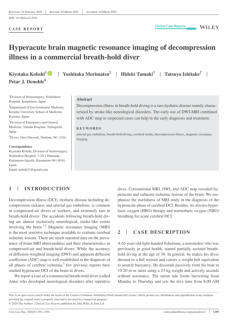Scientific papers 2020 - Part A










Click on the octopus
to return to the top
of the page

Click here




Authors:
Richard V. Lundell, Anne K. Räisänen-Sokolowski, Tomi K.
Wuorimaa, Tommi Ojanen, & Tommi Ojanen.
Diving close to the Arctic circle means diving in cold
water regardless of the time of year. The human body
reacts to cold through the autonomous nervous system
(ANS)-mediated thermoregulatory mechanisms. Diving
also induces ANS responses as a result of the diving reflex.
To study ANS responses during diving in Arctic water
temperatures, the authors retrospectively analyzed
repeated 5-min heart rate variability (HRV) measures and
the mean body temperature from dives at regular
intervals using naval diving equipment measurement tests
in 0 degrees C water.
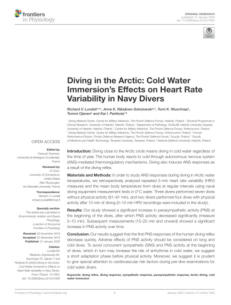

Authors:
Ben Aviner, Ran Arieli, Alexandra Yalov.
Patients undergoing hyperbaric oxygen therapy and
divers engaged in an underwater activity are at risk of
central nervous system oxygen toxicity. An algorithm for
predicting CNS oxygen toxicity during active underwater
diving has been published previously, but not for humans
at rest. Using a procedure similar to that employed for the
derivation of their active diving algorithm, the authors
collected data for exposures at rest, in which subjects
breathed hyperbaric oxygen while immersed in
thermoneutral water at 33 degrees C or in dry conditions.
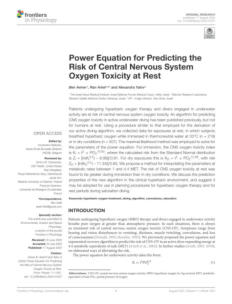

Authors: Marko Žarak, Antonija Perovic, Marina Njire
Braticevic, Sandra Šupraha Goreta, Jerka Dumic.
It has been shown that one diving session is sufficient to
cause changes in plasma level of cardiovascular (CV) and
muscular biomarkers.
To explore whether repetitive diving triggers an adaptive
response of the CV, muscular, and immune system, the
authors measured the cardiac damage, muscle damage,
vascular endothelial activation, and inflammatory,
biomarkers. A longitudinal intervention study included
divers (N = 14) who conducted one dive per week over 5
weeks at the depth of 20–30 m for 30 min after a non-
dive period of 5 months. Blood samples were collected
before and after the first, third, and fifth dives and specific
biomarkers were measured in plasma or serum by the
standard laboratory methods.
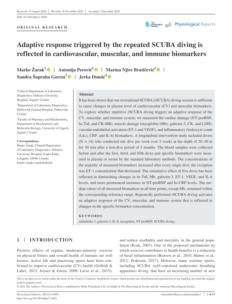

Author: Tahreem Fatima
This article does not speak of diving but on the use of
Hyperbaric oxygen therapy (HBOT) as a primary
emergency treatment in some acute pathologies or
alternative therapies, particularly in deep and chronic
infections such as necrotizing fasciitis, osteomyelitis,
chronic
soft tissue infections, and infective endocarditis for chronic
long-term pathologies.
Teams equipped with chambers should be informed that
they can be used in case of such pathologies are found
on the worksite.
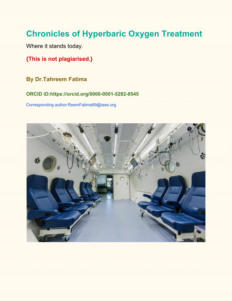

Authors:
Bobby Glenn Warren, Jason Masker, Gregory Brown,
Isabella Gamez, Becky Smith, Deverick J. Anderson, and
Nicholas Turner
This study evaluates the efficacy of 2 UV-C devices for
disinfection of surfaces contaminated with
epidemiologically important pathogens (EIPs) in
hyperbaric chambers of varying shapes.
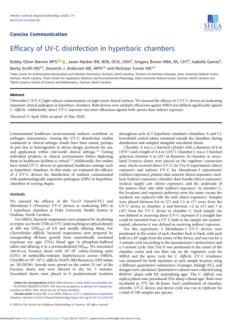

Authors:
Juan C Dapena, Corine A Lansdorp, Simon J Mitchell
The authors present the history and imaging of a diver
diagnosed with DCS treated with two US Navy Treatment
Table 6 recompressions but still had multiple extravascular
bubbles apparent on CT-imaging after these hyperbaric
treatments. Based on these findings, they hypothesize that,
contrary to general belief, it is possible that large
extravascular bubbles can persist after definitive treatment
for DCS.
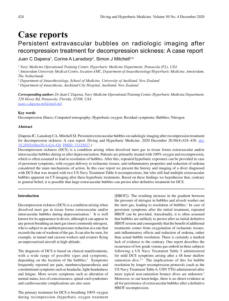

Authors:
Francisco de Asís-Fernández, Tamara del Corral, Ibai
López-de-Uralde-Villanueva
After a maximal apnea, breath-hold divers must restore
O2 levels and clear CO2 and lactic acid produced.
High intensity interval training (HIIT) and inspiratory
muscle training (IMT) could be employed with the aim of
increasing recovery capacity. This study aimed to evaluate
the relative effects of IMT versus HIIT on recovery of
peripheral oxygen saturation (SpO2), and also on
pulmonary function, inspiratory muscle strength, lactate
and heart rate recovery after a maximal dynamic apnea in
breath-hold divers.
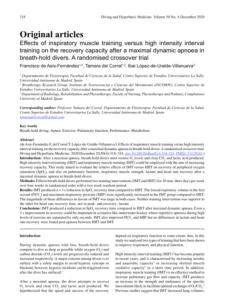

Authors:
Peter Germonpré, Paul Van der Eecken, Elke Van
Renterghem, Faye-Lisa Germonpré, Costantino Balestra.
The Azoth Systems O’Dive bubble monitor is marketed at
recreational and professional divers as a tool to improve
personal diving decompression safety. We report the use
of this tool during a l2-day dive trip aboard a liveaboard.
Six divers were consistently monitored according to the
user manual of the O’Dive system. Data were
synchronised with the Azoth server whenever possible
(depending on cell phone data signal). Information
regarding ease of use, diver acceptance and influence on
dive behaviour were recorded.
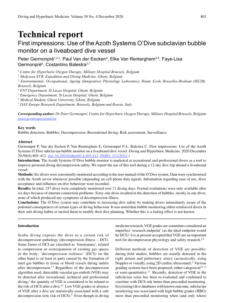

Authors:
Babak Hajhosseini, Britta A. Kuehlmann, Clark A. Bonham,
Kathryn J. Kamperman, Geoffrey C. Gurtner
As suggested in the title, this document reviews the
various technics used for Hyperbaric Oxygen therapy. It
can be used as a complementary source of information
regarding the positive use of hyperbaric oxygen.
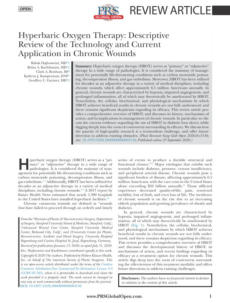

Authors: Brian T Andrew, David J Doolette
The US Navy air decompression table was promulgated in
2008, and a revised version, calculated with the VVal-79
Thalmann algorithm, was promulgated in 2016. The
Swedish Armed Forces conducted a laboratory dive trial
using the 2008 air decompression table and 32 dives to
40 metres‘ seawater for 20 minutes bottom time resulted
in two cases of decompression sickness (DCS) and high
venous gas emboli (VGE) grades. These results motivated
an examination of current US Navy air decompression
schedules.
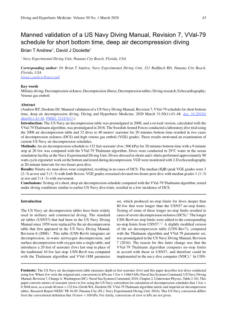

Authors: Andrzej Molisz,Tomasz Przewozny,Katarzyna
Nowicka-Sauer, Marta Sauer
The role of the cardiovascular system in the development
of seasickness remains uncertain. Material and Methods:
Overall, 18 healthy students (10 males and 8 females)
aged 18–24 years volunteered in the project, spending
2–7 h on life rafts. The cardiovascular system was
examined with impedance cardiography. Susceptibility
and symptoms of seasickness were evaluated by the
Motion Sickness Susceptibility Questionnaire Short-form
(MSSQ-Short) and the Motion Sickness Assessment
Questionnaire (MSAQ). The Visual Analogue Scale (VAS),
ranging 0–10, was used to assess nausea, dizziness and
mood. The parameters were assessed at 2 time points.
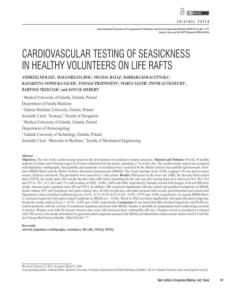

Authors: Kåre Segadal, Andreas Møllerløkken
This study was done on initiative from PSA. The objective
was to investigate emergency decompression as an
alternative, in cases where the evacuation from a
saturation facility of divers at increased pressure, is not
available for whatever reason. It is stressed that it will not
be the purpose of such procedures to prevent pain or
discomfort, but to prevent serious injury and death.
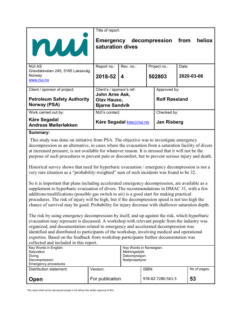

Authors:
Brunon Kierznikowicz, Władysław Wolański, Romuald
Olszanski
The article describes a diver performing a dive at small
depths in a dry suit, breathing from a single-stage
apparatus placed on his back. As a result of training
deficiencies, the diver began breathing from inside the
suit, which led to hypoxia and subsequent uncontrolled
ascent. Upon returning to the surface, the diver
developed neurological symptoms based on which a
diagnosis of pulmonary barotrauma was made.
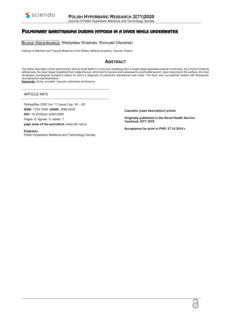

Authors:
Jakub Tlapák, Boris Onišcenko, Petr Došel, Pavel Požár, Petr
Chmátal, and Michal Hájek
Pneumothorax as a consequence of pulmonary
barotrauma during explosive decompression military
crew training in a hypobaric chamber is an extremely rare
and sparsely diagnosed complication. Extensive bilateral
tissue damage is even more unexpected.
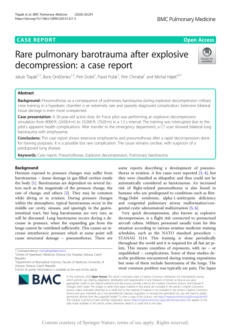

Authors:
Xavier CE Vrijdag, Hanna van Waart, Jamie W Sleigh,
Simon J Mitchell
Gas narcosis impairs divers when diving deeper.
Pupillometry is sensitive to alcohol intoxication and it has
been used in anaesthesia to assess nitrous oxide narcosis.
It is a potential novel method to quantify narcosis in
diving. The aim of this study was to evaluate pupillometry
for objective measurement of narcosis during exposure to
hyperbaric air or nitrous oxide.
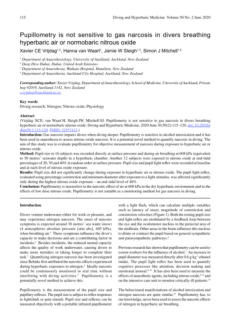

Authors:
Sergey S. Petrikov, Anatoly K. Evseev, Olga A. Levina, Aslan
K. Shabanov, Vladimir V. Kulabukhov, Natalia Yu.
Kutrovskaya, Natalia V. Borovkova, Elena V. Klychnikova,
Irina V. Goroncharovskaya, Elizaveta V. Tazina, Konstantin
A. Popugaev, Denis A. Kosolapov, Daria S. Slobodeniuk
Patients diagnosed with new coronavirus infection caused
by SARS-CoV-2 virus were examined. Hyperbaric oxygen
therapy sessions were conducted on 57 patients, 38 in
severe condition (CT 3–4) and 19 in moderate condition
(CT 1–2). The procedures were performed in the 1.4–1.6
ATA mode for 40 minutes, 247 sessions were performed.
The effect of hyperbaric oxygenation was assessed by
measuring the level of oxygen saturation, the severity of
oxidative stress, and the apoptosis of blood lymphocytes.
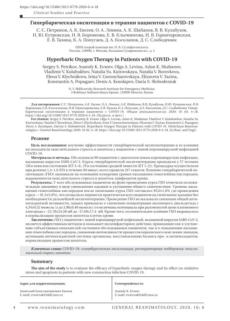

Author: Amy Elizabeth King
This paper focuses on decompression sickness (DCS)
resulting from hyperbaric exposure, specifically,
underwater diving. The US Navy uses probabilistic
decompression models to gain insight into the level of risk
posed by a particular time-depth profile. These models
quantify the probability of DCS occurring using survival
analysis and a gas content or bubble volume model to
define the risk. Current probabilistic models make a
binomial prediction of the probability of DCS occurring
and not occurring.
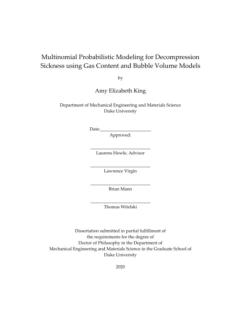
Authors: Stecia-Marie P. Fletcher, Natalia Ogrodnik, and
Meaghan A. O’Reilly
The authors developed a short-burst, phase-locked
focused ultrasound to address standing waves in the
human spinal canal. They demonstrated that microbubble
emissions from these pulses can effectively open the
blood-spinal cord barrier,which can be detected through
the human vertebral arch.Using a dual aperture approach
and pulse inversion (PI) at 514 kHz, the authors sonicated
circulating microbubbles through ex vivo human
vertebrae.

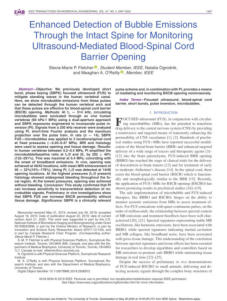

Authors: Mary Mallappallil, Jacob Sabu, Angelika
Gruessner, and Moro Salifu
Big data refers to extensive datasets that traditional
software cannot handle. The medical field is likely to use it
more in various sectors, including business, academia,
government, and public areas. This includes all sorts of
health data, such as biobanks, wellness devices, medical
records, demographics, and images. Big data is also
changing research methods. Due to more affordable
computing, it is easier to gather massive amounts of data,
use biobanks, design more adaptable studies, and boost
teamwork across different sectors.
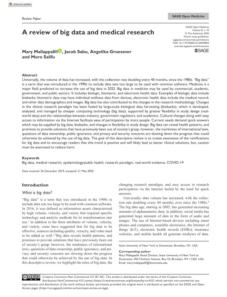

Authors: Amy E. King, Laurens E. Howle
This work focuses on hyperbaric exposure, particularly
decompression sickness (DCS) resulting from diving. The
signs and symptoms of DCS can range from mild rashes
and joint pain to severe neurological and cardiac
dysfunction, and even death. In this paper, a probabilistic
model for predicting the tetranomial outcomes of severe,
mild, marginal, and no DCS, was analyzed and compared
with the trinomial and trinomial marginal models from a
previous paper.
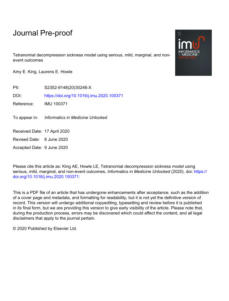

Authors: Qiang Yao, Feng Xu, and Jiabao Lin
This document is a qualitative research study on pre-
performance routines (PPRs) specific to elite Chinese
athletes in competitive diving. It identifies and categorizes
the components and stages of PPRs in diving, providing a
comprehensive understanding of the psychological and
behavioral patterns involved. It informs the development
of PPRs for diving athletes and suggests directions for
future research on PPRs in other sports.
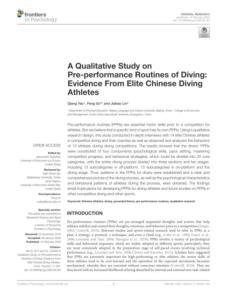

This text informs and cautions about the challenges and
risks associated with recreational diving during the COVID-
19 pandemic. It highlights the impact of global preventive
measures on healthcare resources, the difficulties in
maintaining safety protocols during diving, and the
potential risks of diving-related illnesses that may be
exacerbated by the current scarcity of medical resources
and hyperbaric chambers, in addition to raise awareness
about the complications and necessary precautions for
diving activities in the context of the pandemic.
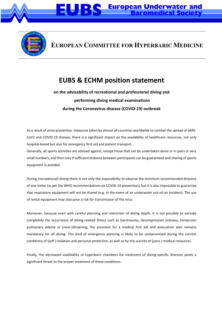

Authors: Johnny Conkin, Ph.D.
This document intends to present research findings and
methodologies related to decompression sickness (DCS)
and venous gas emboli (VGE) in the context of hypobaric
decompressions, particularly for astronauts. It aims to
explain the probabilistic nature of DCS, describe the
methods used to model and predict the occurrence of
DCS and VGE and discuss the implications of these
models for planning extravehicular activities (EVAs) in
space exploration.
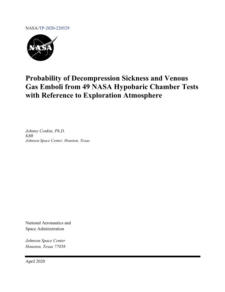

Authors: Gianluca Di Muro, F. Gregory Murphy, Richard D.
Vann, Laurens E. Howle
This research focused on developing and evaluating
interconnected tissue compartmental models for
predicting decompression sickness (DCS) in compressed
gas diving, outlining the extension of previous models to
include multiple risk-bearing compartments and discussing
the training and evaluation of these models using a large
dataset. The report also highlights the exploration of
model performance, particularly in predicting DCS in
humans for dives outside the training set, and identifies
the most successful model configuration.
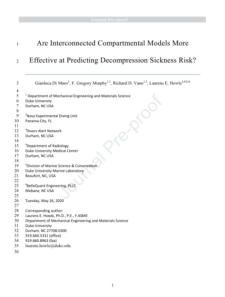

Author: Ryszard Kłos
This document provides information about applying and
evaluating a sonography technique, specifically the
Doppler method, for detecting the free gas phase in
intravascular settings related to decompression research. It
discusses the methodological approach, including the use
of Bayesian validation, and highlights the differing
opinions on the effectiveness of this method in predicting
decompression risk. It also provides historical context on
how this technique has been adopted and developed by
various countries, particularly by the Polish Naval
Academy, which has been using it for over 25 years.
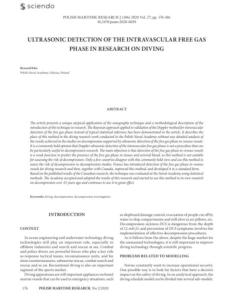

Authors: Eduardo García, Simon J Mitchell
This document presents a scientific study on the
pathophysiology of cutaneous decompression sickness
(DCS), specifically cutis marmorata, in divers. It aims to
share findings from an investigation that used ultrasound
and echocardiography to examine the presence of
bubbles in the skin and the potential role of a right-to-left
shunt (RLS) in the condition. It also discusses hypotheses
about the formation and movement of bubbles in the skin
and suggests that ultrasound can be helpful for further
research in this area.
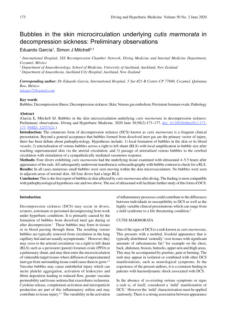

Authors: Rasads Misirovs, and Shwan Mohamad
A young female patient presented to ear, nose, and throat
clinic with long history of left sided facial pain exacerbated
while flying and being in high altitude. Examination of
nasal cavity and computed tomography scan of sinuses
suggested left maxillary sinus barotrauma. Endoscopic
sinus surgery was performed completely resolving her
symptoms. Based on her symptoms and examination
findings she had reverse squeeze sinus barotrauma.


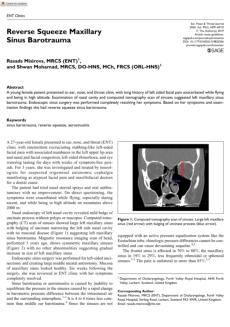



07 - Hyperacute brain magnetic resonance imaging of
decompression illness in a commercial breath-hold diver
- Published by Clinical Case Reports - Wiley
Authors: Kiyotaka Kohshi, Yoshitaka Morimatsu,
Hideki Tamaki, Tatsuya Ishitake, Petar J. Denoble
Decompression illness in breath-hold diving is a rare
dysbaric disease mainly characterized by stroke-like
neurological disorders. The early use of diffusion-
weighted imaging (DWI) and Magnetic resonance
imaging (MRI) combined with apparent diffusion
coefficient (ADC) map in suspected cases can help in the
early diagnosis and treatment.
